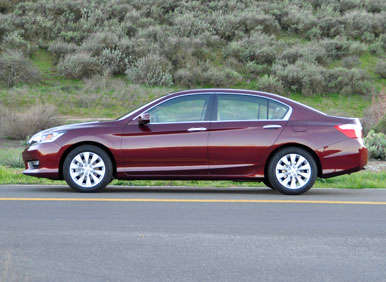Recent Articles
Popular Makes
Body Types
2013 Honda Accord Sedan Road Test and Review
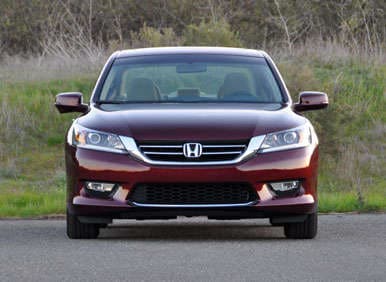
After focusing on SUVs for two decades, car companies are back to making sure their bread-and-butter family sedans are up to snuff. Since 2011, all the heavy-hitters have been redesigned, including the 2013 Honda Accord, and the redesigned Accord rolls onto the midsize car battleground at the same that Chevrolet debuts a new Malibu, that Ford introduces a new Fusion, and that Nissan launches a new Altima. The paint on the redesigned 2012 Toyota Camry and 2012 Volkswagen Passat is barely dry, and Mazda is already selling the all-new 2014 Mazda 6.
To be fair to Honda, the company has always understood the importance of fielding a competent midsize sedan, and consumers have rewarded the automaker with consistently strong Accord sales irrespective of how car-buying patterns have shifted with the wind. Despite stronger and more sophisticated competition than ever, and based on more than 1,200 miles driving the 2013 Honda Accord EX pictured here, my bet is that Honda will continue to dominate sales charts and enjoy a starring role in the nightmares of competing car manufacturers.
2013 Honda Accord Sedan Road Test and Review: Models and Prices
The redesigned 2013 Honda Accord is offered in 2-door coupe and 4-door sedan body styles, with a range of trim levels and a choice between a 4-cylinder or a V-6 engine. This review pertains only to the new Accord Sedan, which starts at $22,470 in LX trim with a manual transmission, including the reasonable $790 destination charge. Opt for a continuously variable transmission (CVT) and the 2013 Accord LX costs just $800 more.
For 2013, the Accord Sport model is new. Equipped with a choice of a manual gearbox ($24,180) or a CVT with paddle shifters ($24,980), the Accord Sport adds a few extra horsepower, fog lights, a rear spoiler, and appealing 18-inch aluminum wheels. Inside, the driver’s seat offers 10-way adjustment including lumbar support, and the steering wheel is wrapped in leather.
If the Accord Sport isn’t suitable, the Accord EX is the next model up from the Accord LX. In EX trim, the Accord gets a manual transmission ($25,395) or a CVT ($26,195), plus 17-inch aluminum wheels, keyless entry with push-button start, a power sunroof, and a Lane Watch blind-spot monitoring system.
The 2013 Accord EX-L is equipped only with a CVT ($28,795), and adds leather, a 10-way power driver’s seat, a 4-way power front passenger’s seat, heated front seats, and a touchscreen audio system with satellite radio and HondaLink smartphone pairing and mobile application technology. Additionally, the EX-L is equipped with LED brake lights, an upgraded reversing camera system, a Forward Collision Warning system, and a Lane Departure Warning system.
For an extra $2,000, the Accord EX-L can be equipped with a hard-disc drive navigation system with voice recognition, an 8-inch high-resolution display screen, 16GB of music storage capacity with Song By Voice technology, and illuminated steering wheel controls. The EX-L model is also offered with a more powerful V-6 engine ($2,075), which is accompanied by a universal programmable remote control, LED running lights, and a conventional 6-speed automatic transmission.
At the top of the lineup, the new Accord Touring ($34,220) includes EX-L trim, the navigation system, and the V-6 engine, and adds automatic LED headlights and an Adaptive Cruise Control system.
Aside from the navigation system and the V-6 engine that are offered for the Accord EX-L, dealers are responsible for installing options on an Accord. I’m no fan of this approach. For example, were I shopping for a new Accord, I’d want the Sport model. But I’d also want all the stuff that comes on the EX-L model. Honda doesn’t allow for that, which means I’d have to settle for an Accord that wouldn’t meet my requirements, or buy something from a competing automaker.
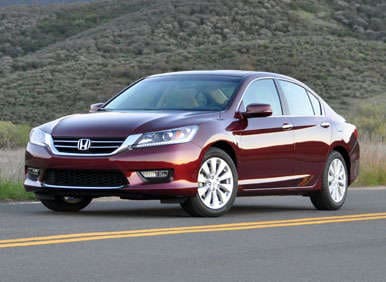
2013 Honda Accord Sedan Road Test and Review: Design
- Redesigned inside and out
- Shorter length and wheelbase
- Standard aluminum wheels
- Available LED running lights, headlights, and taillights
The new Accord Sedan is attractive, in a generic and inoffensive sort of way. Surprisingly conservative – Honda usually alternates between safe and daring design between iterations of its best-selling model – the 2013 Accord is unusually derivative. Every time I see one from the back I’m reminded of the original Hyundai Genesis Sedan. That, combined with multi-spoke aluminum wheels on most models and generally upscale detailing, helps to ensure that the Accord conveys value at its price point.
With the interior, Honda wanted to reduce the visual clutter of the previous model, and the company succeeded. The new car looks and feels constructed of quality and exhibits attention to detail, for the most part. Tones and textures match, and the two-tone approach employing black carpeting gives the Accord’s cabin a richer appearance.
That said, the brushed plastic trim inside of my Accord EX test car looked like a preschooler’s project involving plywood and 5-Minute Fence Stain, and the Accord’s storage locations could use rubber liners to help quell vibration of items stored there.
The beautiful gauge cluster helps make up for these transgressions. The gauges are large, clear, and marked with a classy-looking font. A circular data screen in nestled within the center of the large speedometer, and when the car is driven economically green lighting illuminates to help encourage the driver to go light on the gas.
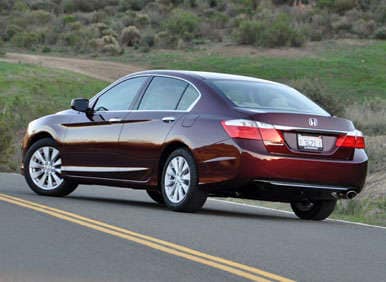
2013 Honda Accord Sedan Road Test and Review: Comfort and Cargo
- Redesigned seats
- Quieter interior
- More rear legroom
- Larger trunk
Perhaps more than anything, what people familiar with previous Accord models are likely to notice about the 2013 model is how quiet it is. On the highway, depending on the road surface, the previous Accord’s level of road noise was occasionally deafening. I drove this 2013 Accord EX all over the state of California with three of my kids aboard, and conversation was only a problem due to iPods, not road noise, thanks to standard Active Noise Control and Active Sound Control technologies, as well as suspension and aerodynamic modifications.
What’s better is that this remarkable improvement in quietude comes not at the expense of critical aural cues from the suspension and tires about what’s happening at the road surface. That, readers, is what “refinement” smells like.
As I mentioned, I spent lots of time piloting the Accord, and sitting on its redesigned driver’s seat. It was never uncomfortable, even during a 9-hour day, but neither am I inclined to rip one out of the car and turn it into a desk chair. In this class, I prefer the Nissan Altima’s new NASA-inspired “zero gravity” seat design. Additionally, you should know that the Accord offered just enough front legroom to accommodate my 33-inch inseam legs. Anyone with longer lower appendages is unlikely to be happy.
I wouldn’t want to ride in the Accord’s back seat for very long. It is very roomy, with all kinds of legroom and foot space under the front chairs, but the seat itself is flat, mounted a little bit too low for comfort, and reclined a little bit too much for my liking. It’s like a park bench, but without the thigh support. Again, the Altima is superior in this regard.
The Accord is very easy to get into and out of, and the doors are shaped in such a way as to make entry and exit easier in tighter parking spaces. Note, however, that on dry, low-humidity days, the Accord’s fabric seats generate static electricity, resulting in fingertip shock when closing the doors, opening the gas door, etc.
During a family road trip, the Accord’s roomier-for-2013 trunk easily accommodated luggage for four people. Unfortunately, the remote trunk release on my test car’s keyfob was inoperable, and Honda doesn’t offer a touchpad trunk release under the license plate brow. This situation became a real hassle given the number of times I found it necessary to access the trunk during the trip.
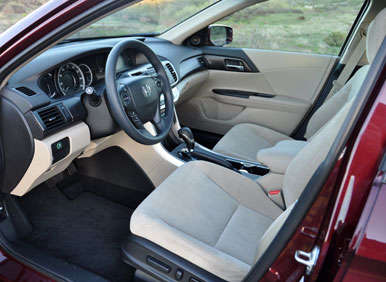
2013 Honda Accord Sedan Road Test and Review: Features and Controls
- Standard Bluetooth, USB, SMS text messaging
- Standard dual-zone automatic climate control
- Standard three-blink lane change indicator function
- Available HondaLink cloud-based connectivity technology
- Available Smart Entry & Push Button Start system
The new Accord’s dashboard is clean and modern, and offers large, clearly marked, and logically placed controls. My Accord EX test car did not have the in-dash color touchscreen that is included with HondaLink technology, but did offer a large display at the top of the dashboard offering trip computer information, radio information, and the LaneWatch display.
Notably, Honda locates the Accord’s parking brake on the center console, operated using a good old-fashioned handle, which means you’ll never drag the top of your left Johnston & Murphy cap-toe along the underside of a parking brake pedal, thereby ruining the shoe. Been there, done that.
The Accord’s hazard-flasher button is located at the bottom of the stereo controls (the HondaLink display screen on EX-L and Touring models), where it is easy to accidentally activate. My teenager, while fiddling with the stereo, did so, and I drove down California’s Interstate 5 for who-knows-how-long with my flashers on. Maybe that button could be moved.
I’d also like to see Honda add a shallow tray above the stereo controls and in front of the dashboard’s upper display screen. During my road trip, I placed items there anyway, but dust and grit on the hard plastic caused minor scratches. At the very least, this surface ought to be lined with rubber to hold items in place and eliminate potential for damage to the finish.
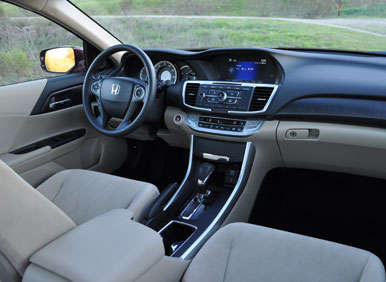
2013 Honda Accord Sedan Road Test and Review: Safety and Ratings
- New Advanced Compatibility Engineering II body structure
- Standard reversing camera
- Standard Bluetooth with SMS text messaging capability
- Standard expanded-view driver’s side mirror
- Standard SmartVent front side-impact airbags
- Available LaneWatch display
- Available Lane Departure Warning system
- Available Forward Collision Warning system
- Available Adaptive Cruise Control system
Based on the list of changes, it is clear that, with the 2013 Accord redesign, Honda wanted to take a leap forward with regard to safety. The car’s next-generation Advanced Compatibility Engineering II (ACE II) body structure is designed to provide greater occupant protection in a collision, Bluetooth and hands-free text messaging capability are designed to keep the driver’s hands on the wheel, the standard reversing camera provides a clear view to the rear of the car, and if you’re willing to buy the EX-L model, a Lane Departure Warning system is aboard to assist the driver.
What I’d like to discuss here, however, is the Accord’s LaneWatch technology, which is standard on all versions except the LX and the Sport. This is more than just a blind-spot information system. LaneWatch employs a camera mounted to the bottom of the right side mirror, and when the driver signals a turn, it shows what’s along the right side of the car on the in-dash screen, along with guidance lines that help the driver to see if it is safe to make a lane change. The driver can also manually activate LaneWatch by pressing the button on the end of the turn signal stalk. It’s a useful technology, and a unique approach to blind spot monitoring.
In NHTSA crash-tests, the 2013 Accord Sedan receives 4-star frontal-impact ratings for the driver and front passenger, 5-star side-impact ratings for the front and rear seat occupants, and a 5-star rollover resistance rating. The Accord’s overall score is 5 stars, the highest possible.
Likewise, the new Accord Sedan achieves the highest possible crash-test rating from the Insurance Institute for Highway Safety (IIHS), a “Top Safety Pick+” designation thanks the Accord’s top-rated performance in the new small overlap frontal impact crash test.
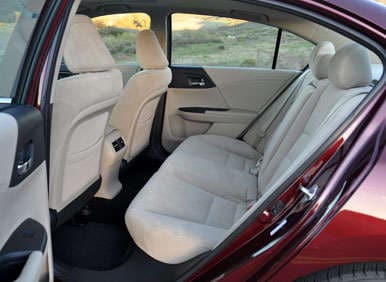
2013 Honda Accord Sedan Road Test and Review: Engines and Fuel Economy
- New “Earth Dreams” powertrain lineup
- Standard Econ button with Eco Assist system
- Available CVT with “G-Design Shift” logic
- New electric steering helps increase fuel economy
- Hybrid and Plug-in Hybrid models coming for 2014
Honda offers Accord Sedan buyers a choice between a new direct-injected 2.4-liter 4-cylinder engine and an updated 3.5-liter V-6 engine with Variable Cylinder Management (VCM) technology, which is designed to shut half of the engine’s cylinders off to help conserve fuel under certain driving conditions. The 4-cylinder is offered with a 6-speed manual transmission or a continuously variable transmission (CVT) with G-Design Shift logic that succeeds at making power delivery feel more like a regular automatic. The 278-horsepower V-6 is equipped with a 6-speed automatic transmission.
My Accord EX test car had the 4-cylinder engine and the CVT. This “Earth Dreams” powerplant is rated to make 185 horsepower at 6,400 rpm (189 horsepower in the Accord Sport model) and 181 lb.-ft. of torque at 3,900, and in combination with the responsive CVT provides plenty of motivation for the EX model’s 3,267-lb. curb weight. The Accord Sport models offer paddle shifters when equipped with the CVT.
According to the EPA, the Accord’s 4-cylinder is expected to return 27 mpg in the city, 36 mpg on the highway, and 30 mpg in combined driving when paired with the standard CVT, like my test car. Accord Sport models drop 1 mpg across the board. I averaged 30.4 mpg, and while that included lots of highway slogging, it also reflects hustling up the Pacific Coast Highway on the scenic coastal road, battling traffic in downtown Los Angeles and San Francisco, and carrying a full load of passengers and cargo nearly the entire time.
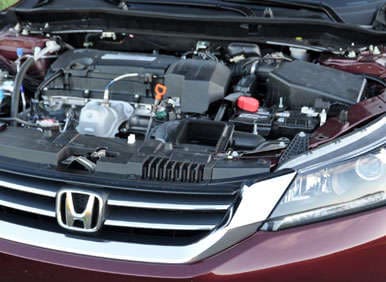
2013 Honda Accord Sedan Road Test and Review: Driving Impressions
Honda engineers ought to be performing weekend shows at Hollywood’s Magic Castle. Polished, refined, competent, and capable, the Accord’s dynamic tuning calls little attention to itself while simultaneously delivering exactly what most midsize sedan owners want most of the time, regardless of the circumstance.
Let’s start with the 4-cylinder engine, which delivers a compelling blend of power and fuel economy, assisted by a CVT that does a good job of faking the stepped shifts of a traditional automatic, eliminating much of the annoying steady-rpm drone common with CVTs. Add the noise attenuation efforts Honda has made with this new Accord, and drivers are likely to wonder why anyone might need the available V-6.
Electric steering is new for 2013, and it feels absolutely natural except at low speeds, where I noticed during parking maneuvers that it displays an active-steering effect to make it easier to slip into a slot. The steering wheel itself is properly sized and shaped, and I didn’t really miss the fact that my EX test car lacked a leather-wrapped tiller.
Similarly, the Accord’s brake pedal is perfectly calibrated, responsive, easy to modulate, a confidence builder underneath the driver’s foot. Under duress on a twisty mountain road, however, I did detect some fade and vibration, a clear indicator that while an Accord is great to drive, it’s not necessarily fun to drive.
Driven with gusto near the car’s limits, the body rolls in corners and the tires push easily in hairpin turns, underscoring the Accord’s role as a family sedan and not a sport sedan. That said, neither is the Accord a chore to drive thanks to clear lines of communication between the driver and the road surface, combined with refined mechanicals that allow the driver to make best use of the car’s talents. At more modest speeds, on roads with fewer sharp curves, the Accord feels lightweight and lively, a willing dance partner that seems to know all of your best moves…and to know how to make up for your worst.
Most Accord owners are going to spend their time plying city streets, suburban boulevards, and freeways. Here, the Accord deftly isolates road rash and provides a composed ride quality blended with the tactile and aural indicators any driver can appreciate.
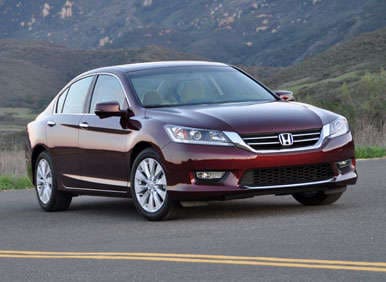
2013 Honda Accord Sedan Road Test and Review: Final Thoughts
Measured against the list of reasons car buyers claim they choose a new vehicle*, the redesigned 2013 Accord hits all the right notes. It is fuel-efficient, it is safe, it is affordable, it exhibits quality, it offers advanced technologies, and it enjoys a long-standing reputation for durability. That the new Accord is also enjoyable to drive is an added bonus.
* Based on Consumer Reports and J.D. Power and Associates data
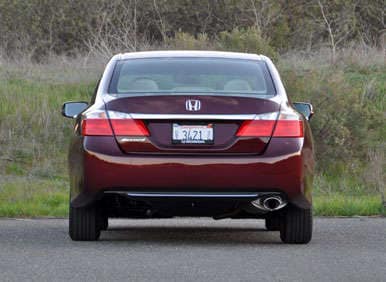
2013 Honda Accord Sedan Road Test and Review: Pros and Cons
- Appealing design
- Quiet interior
- Impressive list of standard equipment
- Excellent crash-test ratings
- Terrific 4-cylinder engine and CVT
- 30+ MPG without trying
- Enjoyable to drive, if not quite fun
- Inability to mix and match equipment
- Requires minor attention to cabin details
- Rear seat lacks shaping and support
- Safety-related technology requires purchase of more expensive models
Honda supplied the vehicle for this review
2013 Honda Accord EX Sedan photos by Christian Wardlaw
